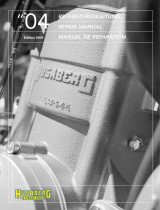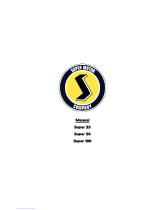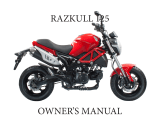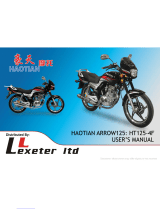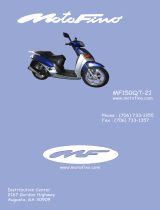TABLE OF CONTENTS
»
ENGLISH
4
INTRODUCTION . . . . . . . . . . . . . . . . . . . . . . . . . . . . . . . . .1
IMPORTANT INFORMATION . . . . . . . . . . . . . . . . . . . . . . . .2
SERIAL NUMBER LOCATIONS . . . . . . . . . . . . . . . . . . . . . .5
Engine number, engine type . . . . . . . . . . . . . . . . . . . . . .5
Chassis number . . . . . . . . . . . . . . . . . . . . . . . . . . . . . . .5
OPERATION INSTRUMENTS . . . . . . . . . . . . . . . . . . . . . . . .5
Clutch lever . . . . . . . . . . . . . . . . . . . . . . . . . . . . . . . . .5
Hot start lever . . . . . . . . . . . . . . . . . . . . . . . . . . . . . . . .5
Hand brake lever . . . . . . . . . . . . . . . . . . . . . . . . . . . . . .6
Short circuit button . . . . . . . . . . . . . . . . . . . . . . . . . . . .6
Combination switch . . . . . . . . . . . . . . . . . . . . . . . . . . . .6
Headlamp switch . . . . . . . . . . . . . . . . . . . . . . . . . . . . . .6
Flasher switch . . . . . . . . . . . . . . . . . . . . . . . . . . . . . . . .6
Starter button . . . . . . . . . . . . . . . . . . . . . . . . . . . . . . . .7
Emergency OFF switch . . . . . . . . . . . . . . . . . . . . . . . . . .7
Indicator lamps . . . . . . . . . . . . . . . . . . . . . . . . . . . . . . .7
Electronic speedometer . . . . . . . . . . . . . . . . . . . . . . . . . .7
Activating and deactivating display modes . . . . . . . . . . . .8
Setting the clock . . . . . . . . . . . . . . . . . . . . . . . . . . . . .11
Overview of the electronic speedometer functions . . . . . .11
Filler cap . . . . . . . . . . . . . . . . . . . . . . . . . . . . . . . . . . .12
Fuel tap . . . . . . . . . . . . . . . . . . . . . . . . . . . . . . . . . . . .12
Choke . . . . . . . . . . . . . . . . . . . . . . . . . . . . . . . . . . . . .12
Shift lever . . . . . . . . . . . . . . . . . . . . . . . . . . . . . . . . . .13
Kickstarter . . . . . . . . . . . . . . . . . . . . . . . . . . . . . . . . . .13
Foot brake pedal . . . . . . . . . . . . . . . . . . . . . . . . . . . . .13
Side stand . . . . . . . . . . . . . . . . . . . . . . . . . . . . . . . . . .13
Steering lock . . . . . . . . . . . . . . . . . . . . . . . . . . . . . . . .13
Compression damping of fork . . . . . . . . . . . . . . . . . . . .14
Rebound damping of fork . . . . . . . . . . . . . . . . . . . . . . .14
Compression damping of shock absorber . . . . . . . . . . . . .15
Rebound damping of shock absorber . . . . . . . . . . . . . . .15
Engine characteristic . . . . . . . . . . . . . . . . . . . . . . . . . .16
GENERAL TIPS AND WARNINGS FOR STARTING THE MOTORCYCLE
.16
Instructions for initial operation . . . . . . . . . . . . . . . . . . .16
Running in . . . . . . . . . . . . . . . . . . . . . . . . . . . . . . . . . .16
DRIVING INSTRUCTIONS . . . . . . . . . . . . . . . . . . . . . . . . .17
Check the following before each start . . . . . . . . . . . . . . .17
Starting when the engine is cold . . . . . . . . . . . . . . . . . .18
Starting when the engine is warm . . . . . . . . . . . . . . . . .18
What to do when the engine is „flooded“ . . . . . . . . . . . .18
Starting off . . . . . . . . . . . . . . . . . . . . . . . . . . . . . . . . .18
Shifting/Riding . . . . . . . . . . . . . . . . . . . . . . . . . . . . . . .18
Braking . . . . . . . . . . . . . . . . . . . . . . . . . . . . . . . . . . . .19
Stopping and parking . . . . . . . . . . . . . . . . . . . . . . . . . .19
Fuel . . . . . . . . . . . . . . . . . . . . . . . . . . . . . . . . . . . . . .19
PERIODIC MAINTENANCE . . . . . . . . . . . . . . . . . . . . . . . .20
MAINTENANCE WORK ON CHASSIS AND ENGINE . . . . . . .24
Changing the spring preloading of the shock absorber . . .24
Pivot bearing . . . . . . . . . . . . . . . . . . . . . . . . . . . . . . . .24
Basic suspension setup for the weight of the driver . . . . .25
Checking the shock absorber and spring . . . . . . . . . . . . .25
Determining the static sag of the shock absorber . . . . . . .25
Determining the riding sag of the shock absorber . . . . . . .25
Checking the basic setup of the telescopic fork . . . . . . . .26
Changing the spring preload on the telescopic fork . . . . .26
Replacing fork springs . . . . . . . . . . . . . . . . . . . . . . . . .26
Breather plug front fork . . . . . . . . . . . . . . . . . . . . . . . . .27
Cleaning the dust sleeves of the telescopic fork . . . . . . . .27
Checking and adjusting the steering head bearing . . . . .27
Changing the fork offset (caster) . . . . . . . . . . . . . . . . . .28
How to change the handlebar position . . . . . . . . . . . . . .29
Check chain tension . . . . . . . . . . . . . . . . . . . . . . . . . . .30
Correct chain tension . . . . . . . . . . . . . . . . . . . . . . . . . .30
Adapting the chain guide to the number of rear sprocket teeth
.31
Chain maintenance . . . . . . . . . . . . . . . . . . . . . . . . . . . .32
Chain wear . . . . . . . . . . . . . . . . . . . . . . . . . . . . . . . . . .32
General information about KTM disc brakes . . . . . . . . . .33
Adjusting the free travel at the hand brake lever . . . . . . .34
Checking the brake fluid level - front brake . . . . . . . . . . .34
Refilling the front brake fluid reservoir . . . . . . . . . . . . . .34
Checking the front brake pads . . . . . . . . . . . . . . . . . . . .35
Replacing the front brake pads . . . . . . . . . . . . . . . . . . .35
Changing the basic position of the foot brake pedal . . . . .35
Checking the rear brake fluid level . . . . . . . . . . . . . . . . .36
Refilling the rear brake fluid reservoir . . . . . . . . . . . . . . .36
Checking the rear brake pads . . . . . . . . . . . . . . . . . . . . .36
Replacing the rear brake pads . . . . . . . . . . . . . . . . . . . .37
Dismounting and mounting the front wheel . . . . . . . . . . .37
Dismounting and mounting the rear wheel . . . . . . . . . . .38
Checking spoke tension . . . . . . . . . . . . . . . . . . . . . . . . .38
Tires, air pressure . . . . . . . . . . . . . . . . . . . . . . . . . . . . .39
Check/set distance of the magnetic sensor . . . . . . . . . . .39
Replacing the battery of the digital speedometer . . . . . . .39
Battery . . . . . . . . . . . . . . . . . . . . . . . . . . . . . . . . . . . .40
Charging the battery . . . . . . . . . . . . . . . . . . . . . . . . . . .40
Fuse . . . . . . . . . . . . . . . . . . . . . . . . . . . . . . . . . . . . . .41
Replacing headlight lamp/parking light lamp . . . . . . . . . .41
Cooling system . . . . . . . . . . . . . . . . . . . . . . . . . . . . . . .42
Checking the coolant level . . . . . . . . . . . . . . . . . . . . . . .42
Bleeding the cooling system . . . . . . . . . . . . . . . . . . . . .42
Replacing the glassfiber yarn packing of the silencer . . . .43
Cleaning the spark arrester . . . . . . . . . . . . . . . . . . . . . .43
Cleaning the air filter . . . . . . . . . . . . . . . . . . . . . . . . . .44
Adjusting the throttle cables . . . . . . . . . . . . . . . . . . . . .44
Changing the original position of the clutch lever . . . . . . .45
Checking the oil level of the hydraulic clutch . . . . . . . . .45
Bleeding of the hydraulic clutch . . . . . . . . . . . . . . . . . .45
Carburetor – Adjust idling . . . . . . . . . . . . . . . . . . . . . . .46
Basic information on carburetor wear . . . . . . . . . . . . . . .46
Checking the float level (float height) . . . . . . . . . . . . . . .46
Draining the float chamber of the carburetor . . . . . . . . . .46
Checking the engine oil level . . . . . . . . . . . . . . . . . . . . .47
Engine oil . . . . . . . . . . . . . . . . . . . . . . . . . . . . . . . . . .47
Changing the engine oil . . . . . . . . . . . . . . . . . . . . . . . .48
Changing the oil filters . . . . . . . . . . . . . . . . . . . . . . . . .49
TROUBLESHOOTING . . . . . . . . . . . . . . . . . . . . . . . . . . . .50
CLEANING . . . . . . . . . . . . . . . . . . . . . . . . . . . . . . . . . . . .52
CONSERVATION FOR WINTER OPERATION . . . . . . . . . . . .52
STORAGE . . . . . . . . . . . . . . . . . . . . . . . . . . . . . . . . . . . .52
USE AFTER A PERIOD OF STORAGE . . . . . . . . . . . . . . . . .52
TECHNICAL DATA – ENGINE . . . . . . . . . . . . . . . . . . . . . . .53
TECHNICAL DATA – CHASSIS . . . . . . . . . . . . . . . . . . . . . .55
WIRING DIAGRAM . . . . . . . . . . . . . . . . . . . . . . . . . . . . . .57
HEAD WORD INDEX . . . . . . . . . . . . . . . . . . . . . . . . . . . . .61




















